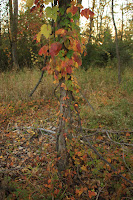I biked to Watersmeet Woods in Northfield at sunset and thankfully someone heeded
my advice from earlier this year and created a trail made of hay along the river so
I wouldn't have to be harassed by spiders hiding in the tall grass (although there
aren't any bugs out at this time of year anyway and one has to walk through tall grass
to get to the trail). Like any secluded part of the forest, there was much more wildlife--
I counted ten wood ducks, two bucks, and a turkey vulture--and the terrain was unique.
The tall grass surrounds the trail on all sides with a few dots of yellow wildflowers,
and opposite the ditch containing part of the Chicago River is a open woods hued with
autumn orange. A completely different scene than the dreary mud-heap I discovered
back in March.
I've officially stopped using my 18-55mm and instead have used the Sigma 18-50mm
as my go-to wide angle lens. The larger/lower aperture setting of f/2.8 makes a surprising
difference by making lighting and colors softer and more saturated. It also works better
in situations with dim lighting. An example of all this working towards the photographers
benefit is the bottom photo: clearly there wasn't much much light (look at how overexposed
the sky compared to the brightness of the tree), the different colored leaves stand out, and
the tree itself is isolated through depth of field.
Northfield
Taken in October 2012

































